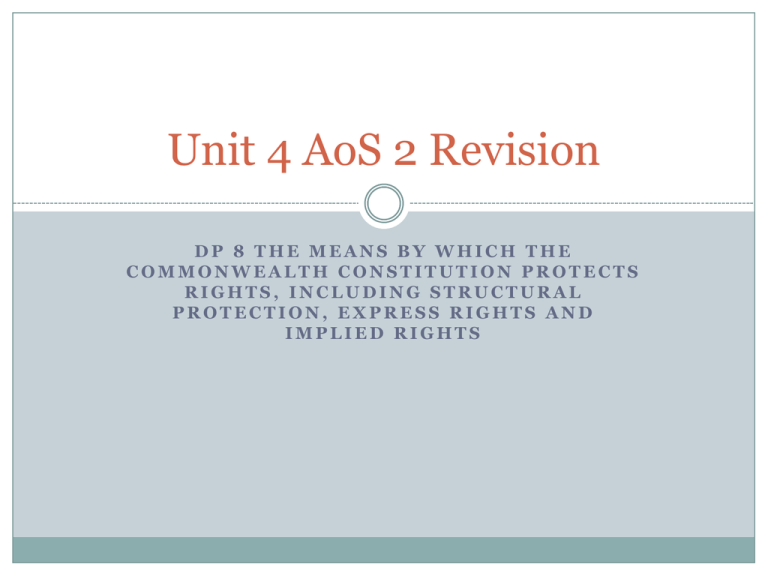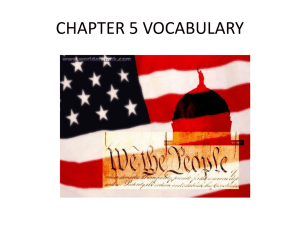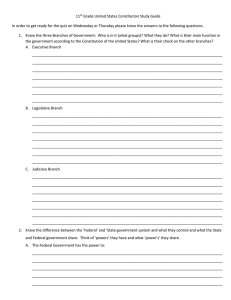Unit 4 AoS 2 Revision
advertisement

Unit 4 AoS 2 Revision DP 8 THE MEANS BY WHICH THE COMMONWEALTH CONSTITUTION PROTECTS RIGHTS, INCLUDING STRUCTURAL PROTECTION, EXPRESS RIGHTS AND IMPLIED RIGHTS General advice The focus of this topic is on how rights are protected in Australia by the Constitution, and how rights are protected by Canada. You may be asked to explain a protected right (see question 1) or discuss all rights (see question 2). Alternatively, questions could focus on the approach used to protect rights in Australia and an evaluation of those means. When undertaking a comparison, the emphasis is on the approach used to protect rights rather then the rights themselves that are being protected. Note that questions on the topic could be combined with other questions in this AoS: division of powers, changing the Constitution. Question 1 Identify and describe one right protected by the Commonwealth Constitution 2 marks. Answer Any of the express rights in the Constitution: Acquisition of property on just terms (s 51 (xxxi). Trial by jury (s. 80) Freedom of religion (s. 116) Question Explain how the Constitution provides for ‘structural protection’ of rights. Structural protection Within the Constitution there are a number of sections that give protection of rights to Australians. Whilst some are expressly protected, other rights are protected indirectly by the structures set up by the Constitution and act as a guard against a misuse of power by the Commonwealth Parliament. These structures such as representative government, responsible government and the separation of powers operate to form a structural protection of rights. Answer See handout. Question 2 Distinguish between express rights and implied rights in the Commonwealth Constitution and give an example of each. 4 marks. Answer Express rights are those rights whose protection is written into the Constitution – the rights are actually stated in the Constitution. For example: S. 116 guarantees freedom of religion by states that the Commonwealth cannot make laws to establish, impose or prohibit any religion. Implied rights are those rights not written in the actual wording of the Constitution but where the High Court has interpreted the Constitution and decided that these rights were intended to be protected by the Constitution. For example, freedom of political communication is an implied right (as developed by the Nationwide News Pty. Ltd vs Wills and Australian Capital Television Pty found that in the system of representative government stated in the Constitution implied that it was necessary to discuss political information and opinions, protecting the right to freedom of political communication). Question Describe the structures and mechanisms that exist within the Constitution that help to protect the rights of Australians. 6 marks. Answer There are a number of structures or mechanisms within the Constitution that operate to indirectly protect rights by preventing a misuse of power by the Federal Parliament. First, s. 7 and 24 provide for a parliament that is chosen directly by the people. These sections help to ensure that we have a government comprising members who will represent the views, values and needs of their electorate and uphold their rights otherwise they may be voted out at the next election. Answer continued Next, the principle of responsible government ensures that the government can only rule if it has the support or confidence of the parliament. If it loses the confidence of the parliament government must resign. Responsible government protects people from being ruled by a government that does not have the support of the lower house. The doctrine of separation of powers, which states that three powers of Commonwealth should be held by different bodies ensures that no one body has absolute control. Each of the arms of government: the legislature, judiciary and the executive acts as a check on the actions of the other arms, which helps prevent the abuse of power. Question Evaluate the means by which the rights of Australians are protected by the Commonwealth Constitution. Answer See the attached handout. Questions Define the following terms: Express rights Implied rights Structural protection Answer Express rights: those rights that are expressly written within the wording of the constitution. Eg…. Implied rights: those rights that are not explicitly stated in the Constitution but have been found by the High Court in interpreting the Constitution to have been intended to protect the Constitution. Eg: Structural protection: Systems or mechanisms in the Commonwealth Constitution that indirectly protect human rights by preventing the misuse of power such as the separation of powers or representative government. An example of structural protection is the limited right to vote in Roach v. Electoral Commissioner (2007). Can you… Demonstrate an understanding of rights and rights protection? Explain the types of rights protected by the Commonwealth Constitution? The approaches used to protect rights in the Comm Constitution: structural protection, express rights and implied rights?





